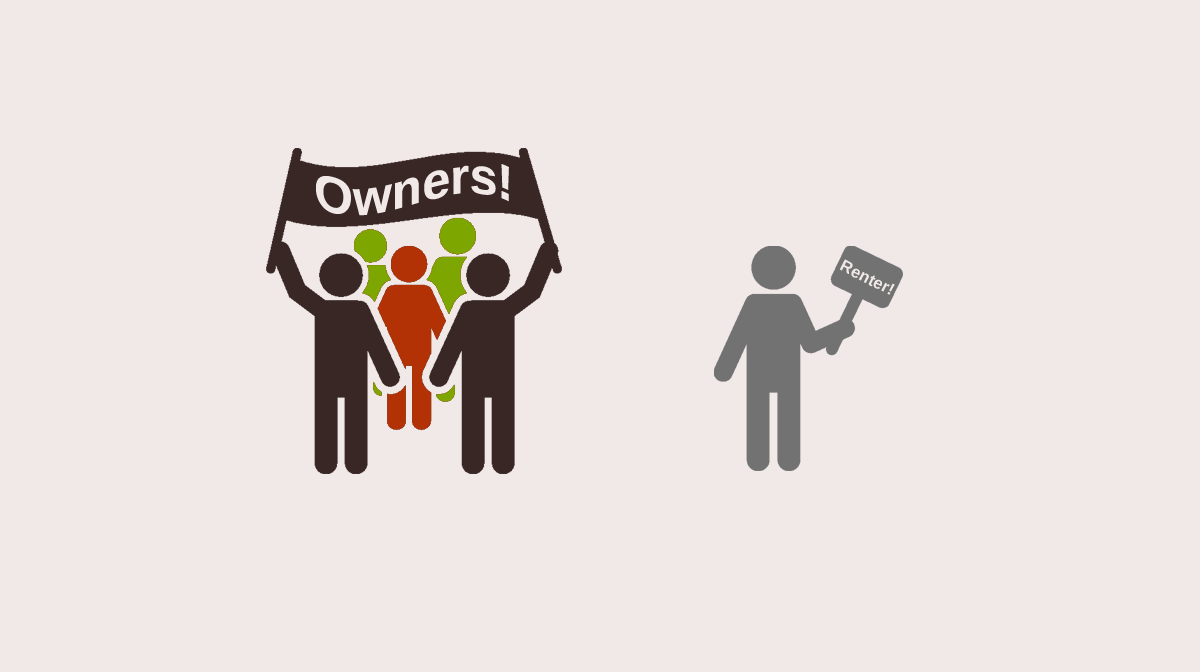The US Census Bureau keeps data from several other national statistical surveys besides the actual census itself. Included in its vast trove of data are the results from the American Housing Survey (AHS), conducted by the US Department of Housing and Urban Development in odd-numbered years. The data from the 2015 survey is just starting to become available now, but the data from 2013 is available in full. When browsing through the AHS 2013 data I came across a unique set of information regarding community involvement for the Chicago area. The survey asked respondents about not only their own involvement in their local community, but also their opinions of their neighbor's involvement in the community, making this a rare opinion poll buried within the normal counting of noses and bathtubs.
The original tallies can be found found here, broken down by owners and renters among other segments. However, there were definitely more owners who replied than renters, making it difficult to get a real comparison of owners vs renters community involvement without converting all the data to percentages. I've done so and embedded the results below. (If the embedded version doesn't show up right for you, here's the full screen version.)
For those of you who prefer some visual guidance I've provided some charts of some of the results below. I've not done charts on the opinion data as there's just too much of it for a blog article.
Is The Information Significant?
Unlike the decennial census, the AHS does not interview every single household. Instead, it takes a sampling of about 5000 households and uses that to estimate the data. The smaller the sample size, the higher the chance that the information will be far different from reality. In the case of the AHS, the deviation could be as high as 5% one way or another. So if we're going to say that there are statistically significant differences between owner and renter replies, we must see at least a 5% gap between the two. In most cases looking at the percentages there is, in fact, at least a 5% difference, so yes, I would say that the gaps are statistically significant.
It's also important when discussing matters specific to the city of Chicago to remember that this survey covered the Chicago Metropolitan area, which includes Cook, DuPage, Grundy, Kane, Kendall, Lake, McHenry and Will counties - in other words, an enormous chunk out of the northern half of the state that spans not only the city proper but many more rural areas that do not have a large renter population. In my opinion this is reflected in the far greater number of "owner" respondents when compared with the renter respondents. Personally I would love to see more fine grain information, as I'd be interested to see the variation in community involvement across Chicago neighborhoods. However, I do not believe that geographical clustering affects the statistical viability of the data as a whole. We just need to remember that we're not just talking about Chicago here.
One missing factor is the length of time spent in the area, although this information is provided in other charts. Renters are generally short-term residents. I would guess that if the numbers provided were averaged based on the number of years the respondents had been living in the community there would be a strong correlation. I may come back to revisit this thought at a later date, and I invite other readers to test the thesis if they feel so inclined.
The data provided is a four year old snapshot. 2013 was an interesting time in Chicago. We were just into the start of Obama's 2nd term. One big issue on the table was the closing of nearly 50 public schools. The same sex marriage bill was enacted. Hadiya Pendleton was killed, prompting a surge of outrage against gang violence. Massive flooding brought residents out in droves to community meetings explaining the city's plans for floodwater management. The city data portal was only one year old, and the civic data movement had exploded. If there was any time during the Obama presidency to take a survey of Chicagoans' involvement in local politics at its peak, 2013 would have been the time to do so.
However, recent opinion polls have stated that 2017 has seen Chicagoans getting politically active at even higher rates than we saw in 2013 as a response to the current federal administration's actions. I will be interested to revisit this data in a couple of years when the 2017 American Housing Survey data becomes available, provided that HUD is allowed to conduct the survey at all.
Observations
The easy read tells us that owners are more involved in the community than renters. It is patently obvious that owners are far more involved in the community than renters are. Looking at the questions about participation in neighborhood activities you see that in all but one case the owners were gathering, connecting and collaborating with their neighbors far more than the renters.
Renters are apparently lonely. There were only three points where renters had a higher response rate than owners. Of those three, the greatest difference is seen in the number of respondents who said they had no friends living nearby, followed by the number of respondents who had only 1 or 2 friends nearby.
It's interesting to note that renters are more likely to speak to religious leaders about local problems than owners are. In all cases respondents are more likely to participate in the community in other ways, but this is the only one of the community involvement questions where renters outnumbered owners. The difference here only 1.62%, which does not exceed the margin of error. However, if I were to draw a conclusion from this category I would say that renters either feel that politicians will not value or heed their concerns, or do not know where to direct their concerns within the community. It's also important to remember that many Chicago communities are ethnic enclaves dominated by the local church, synagogue or mosque rather than by local politics. It may not be a matter of disenfranchisement or confusion, but simply a reflection of the balance of power.
Stepping away from the owner/renter comparison the overall participation in community affairs is pretty low. We only see participation exceed 50% of the respondents in two categories - participation in religious organizations and talking to your neighbors within the past month. Of the remaining categories only volunteering saw participation levels exceed 25%.
The real kicker comes when you compare the self-reported participation rates with the respondents' opinions of their neighbor's activity. In nearly every category, respondents thought that their neighbors were involved in the community, trustworthy, and willing to help each other. What we see here is the root of the problem. People think that their neighbors are better people than they are. People think that their neighbors will act in their best interests. People think that they do not need to participate because someone else on their block surely will do so on their behalf.
While the problems of self-esteem and apathy affect both owners and renters equally, the impact is going to be more severe for renters. Both sides may have rely on others to speak for them, but the person doing the speaking is more likely to be an owner than a renter. Renters may also rely on social service organizations and non-profits focused on tenant protection to speak for them within the community. However, these organizations rarely service specific neighborhoods and cannot be present or even aware of small changes affecting individual neighborhoods.
Apathy Hurts
Renters may be saying, "Hey, I did my part, I voted! The survey doesn't even LOOK at voting!" This is true, it doesn't. However, voting is only a small part of community participation, and many renters who do vote keep their registration elsewhere. Having a voice in your community doesn't stop at putting the right guy or gal in office. You need to continue to instruct them through their elected terms. It's also crucial to remember that the buck does not always stop at your elected officials.
In Chicago there are many things handled by community organizations and town meetings. This includes zoning decisions that affect the construction of additional housing and businesses, CAPS meetings that direct police attention to crimes, litter cleanups, environmental action and school performance.
Renters in certain areas of Chicago have recently expressed outrage over gentrification. Rents are rising and landlords are more stringent than ever about credit checks. Some Chicago communities are seeing more immigration sweeps and deportations - this will affect renters more than owners. Owners are going to be less likely to approve zoning changes that allow high-density residential construction nearby. The entire home sharing ordinance was largely endorsed by owners. The CRLTO has seen challenges to some of its stronger tenant protections in recent years.
Organizations like the Metropolitan Tenants' Union, the Lawyers' Committee for Better Housing and the Chicago Lawyers' Committee for Civil Rights Under Law do great work to help renters. They can't do it all. If you want safe, affordable housing in Chicago you need to step up. If you want to cut down on crime you need to start by talking with your neighbors.
The stats show the prevalence of an urban myth. We all need to stop thinking that our neighbors share our values and will take action on our behalf, but for renters the need to take action is far more severe. If you'd like to start closing the gap between owner and renter community involvement we provided a list last year of 10 ways you can do so. You can also share this article with your neighbor. It might be a nice ice breaker.
RentConfident is a Chicago startup that provides renters with the in-depth information they need to choose safe apartments. Help us reach more renters! Like, Share and Retweet us!


